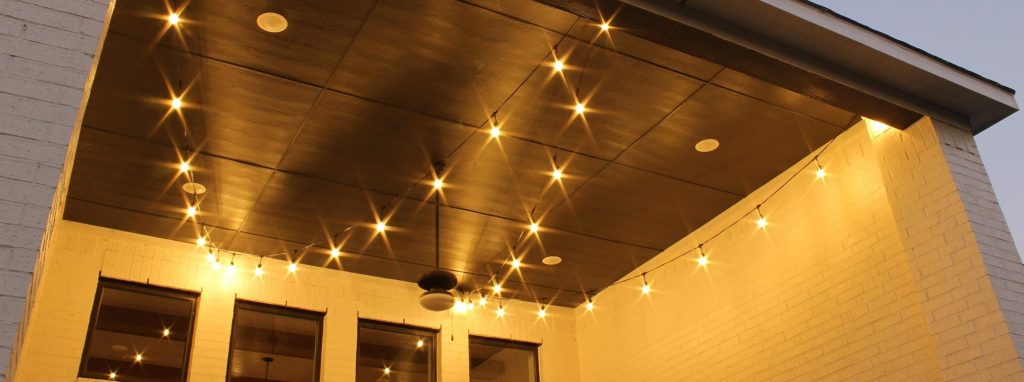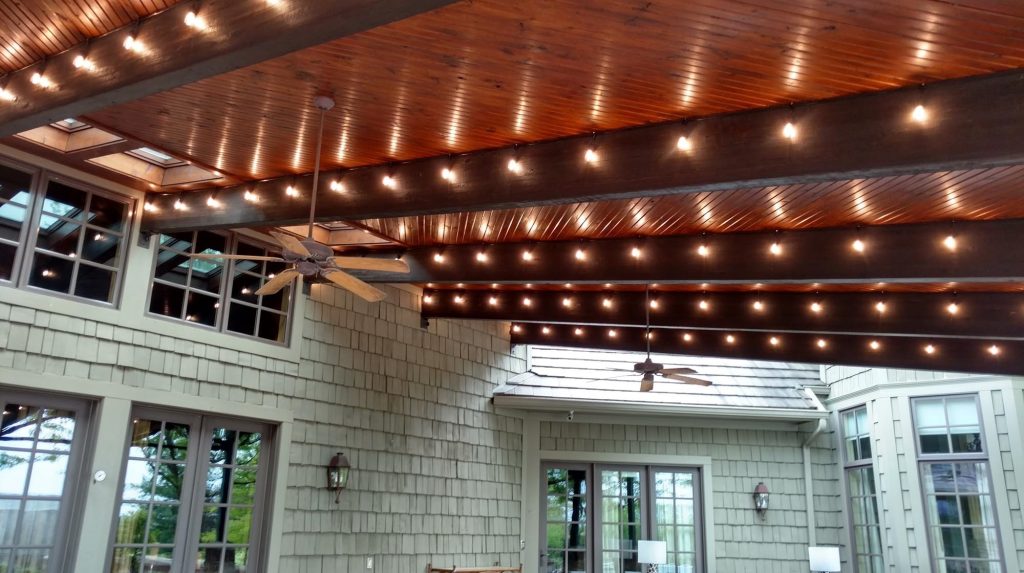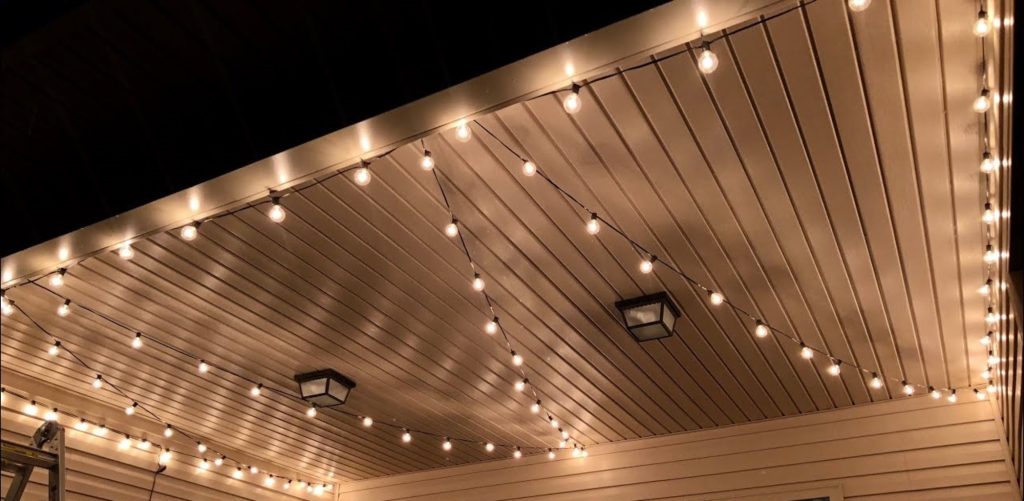An Easy Guide to Hanging Outdoor String Lights on Ceilings
Lighting the Way: The Enchantment of Outdoor String Lights
Outdoor string lights are known for their unique ability to evoke wonder and create an ambiance of warmth, tranquility, and celebration. These strings of brilliance can transform any outdoor area into a charming retreat or a lively party venue with their twinkling illumination.
They add depth to your space by creating a focus on architectural details and highlighting the beauty of your surroundings. By introducing outdoor string lights, you introduce romance, whimsy, elegance, or even festivity into your landscape lighting design.
Outdoor string lights are not merely about ornamentation; they also serve a functional purpose. Navigating through your backyard or patio during nighttime can be challenging without adequate lighting. Strategically placed landscape string lights ensure safety by enhancing visibility while sustaining a warm, inviting atmosphere.
The market is teeming with several types of outdoor string lights that cater to diverse needs and preferences. Whether you desire an intimate glow for cozy conversations or radiant light for dinner parties under the open sky, there is an array of options available.
Shining Bright: Exploring the Spectrum of Outdoor String Lights
The fascinating world of outdoor lighting showcases remarkable innovation in design and technology. Traditional incandescent bulbs that exude a soft, golden glow continue to be beloved by many for their timeless appeal. They are ideal companions for laid-back evenings spent reminiscing over cherished memories.
For those who seek both aesthetics and energy efficiency, light-emitting diode landscape string lights prove to be excellent choices. Known for their longevity and lower power consumption compared to incandescent bulbs, LEDs offer vibrant light that ranges from cool white hues simulating daylight to warmer tones ideal for setting intimate moods.

Solar-powered outdoor string lights represent sustainability at its best. Charged during daylight hours using solar panels attached within each light set-up, they store energy enough to cast a magical glow as the Sun sets. These eco-friendly options are not only cost-effective in the long run but also extend your support towards regenerative energy sources.
Colorful string lights add a dose of fun and festivity to any space. Be it for a splashy poolside party, a festive holiday celebration, or creating a dreamy wonderland for kids, these lights inject an element of joy and playfulness into your outdoor setting.
Regardless of your style or preference, the key is to select string lights that harmonize with the personality of your space and resonate with your individual aesthetic sense. Remember that landscape lighting is more than merely illuminating an area – it’s about painting with light to create an enchanting masterpiece every night.
A Preparatory Overview: Understanding Your Space
Before investing time and money into landscape lighting, it’s essential to understand your space. This involves more than merely appreciating its aesthetic potential but genuinely comprehending the physical dimensions, layout, and environmental nuances of your outdoor area.
Firstly, assess your outdoor area for hanging string lights. This initial assessment is akin to a stage-setting exercise – preparing the canvas before you start painting. It includes deciding where the landscape string lights will be hung, visualizing their arrangement, and determining how they will accentuate the beauty of your space. Remember that strategically hung string lights can dramatically transform mundane spaces into magical vistas.
Determining the Length and Height: The Measure of Beauty
Next on the agenda is determining the length and height needed for your string lights. The length directly corresponds with distance coverage; hence, it’s wise to accurately measure from one attachment point to another for an accurate estimate. It’s important to bear in mind that these are not mere functional figures but dictate aesthetic outcomes too; an excess length might lead to droopy lines, whereas a lack can mar visual continuity.
The height at which string lights hang plays a pivotal role in radiating ambient light across different areas of your space. You should consider hanging them high enough so that people can walk underneath without any obstruction while ensuring they’re low enough to offer intimate lighting effects.
Identifying Attachment Points: Anchoring Your Constellation
Identifying potential attachment points on your ceiling or other structures becomes paramount once you have gauged length and height requirements correctly. These could be sturdy branches if you have trees around or even robust poles installed specifically for this purpose. Attachment points need careful selection as they serve as anchors for hanging outdoor landscape string lights securely while ensuring strain distribution happens evenly across all points.
Considering Weather Conditions: Comprehending Nature’s Influence
But critically, weather conditions and their impacts on outdoor lighting need thorough consideration. Your space might be located in a region that sees frequent rain or high winds. These weather conditions can affect the longevity and functionality of your lights.
In such instances, opting for string lights designed to endure these conditions becomes critical. Whatever the climatic condition or weather challenge your outdoor space comes up against, there’s invariably a solution in the form of appropriate landscape lighting that’ll not only weather the storm but shine through it brilliantly.
Selecting the Right Outdoor String Lights
Unveiling the Variety: LED, Solar, and Incandescent String Lights
When it comes to landscape lighting, especially landscape string lights, there are three main types that you can consider: LED, solar, and incandescent. Each type has its own unique characteristics that make it suited to particular conditions and scenarios.
LED string lights are renowned for their energy efficiency and longevity. They utilize light-emitting diodes instead of traditional filaments, which significantly reduces the amount of energy they need to emit light. This not only makes LED string lights cost-effective in the long run but also environmentally friendly. However, one minor drawback to LED string lights is that they typically emit a very bright white light, which may not be as warm or inviting as other types.
Solar string lights are another intriguing option that offers self-sustainability. As their name suggests, they harness energy from the Sun during the day and illuminate your outdoor spaces at night. One major advantage is that they require no electrical connections, thereby making installation easier and safer. However, their performance heavily relies on weather conditions – if your location doesn’t receive ample sunlight during the day or if it’s a particularly cloudy season, this can affect their brightness and duration of illumination.
Incandescent lights are a classic option known for their warm glow that is reminiscent of old-world charm. They create a cozy ambiance perfect for intimate garden parties or romantic dinners al fresco. However, while charmingly aesthetic, they are less energy efficient than LEDs and have a shorter lifespan.
The Pros and Cons: Navigating Your Choices
There is no definitive answer on which type of string light is superior, as each comes with its own pros and cons influenced by factors such as usage purpose, design preference, and location conditions, among others.
LEDs may not provide the vintage glow that incandescent bulbs do, but their longevity and energy efficiency make them an economical choice for many. Their ability to remain cool to the touch also improves their safety profile.

Solar lights offer the benefit of easy installation and are perfect for areas where running an electric line would be challenging or impractical. However, their dependence on sunlight means they may not be reliable during cloudy days or for landscapes that receive limited sunlight.
Incandescent lights may consume more power but are beloved for the warm, comfy ambience they create. They also come in a range of colors, allowing you to add a splash of personality to your outdoor lighting schemes.
Safety Considerations: Light Your Spaces Safely
Irrespective of the type of string lights selected, safety is paramount. LEDs have the advantage of remaining cool to the touch even after hours of operation, reducing the risk of accidents from overheating.
Solar models sidestep electrical complications altogether as they don’t need power outlets. With incandescent bulbs, ensure all fixtures and wires are securely installed and routinely check for any signs of wear or overheating.
Waterproofing: Ensuring Durability in All Conditions
Regardless of which type you choose, picking waterproof or weather-resistant string lights is crucial when installing outdoor landscape lighting. These types can withstand various weather conditions, including rain, snow, and intense sun exposure, ensuring not only safety but also longer durability, improving overall cost efficiency over time.
Gathering Necessary Tools and Materials
The Essential Toolkit for Effortless Installation of Landscape String Lights
Before embarking on the installation of your landscape lighting, it is crucial to gather all the necessary tools and materials. These will equip you to efficiently execute the task and ensure that your landscape string lights are securely installed.
Firstly, a ladder is indispensable. Depending on the height of your ceiling or other attachment points, you may need a step ladder or an extension ladder. Ensure that your ladder is sturdy and safe to use. It will allow you to reach high points easily, eliminating unnecessary strain and ensuring accurate placement of hooks or clips.
Next in line is a measuring tape. This tool’s importance cannot be overstated when installing landscape string lights. An accurate measurement of your outdoor space will help you determine how many strings of lights you’ll need and how far apart they should be hung.
It would also be beneficial to have a pencil handy for marking spots where hooks or clips will go; this helps ensure precise placement for an aesthetically pleasing arrangement.
The Role Each Tool Plays in Realizing Your Landscape Lighting Vision
Now that we’ve listed all essential tools, let’s delve into why each tool is critical for installing outdoor string lights correctly. The ladder serves as our means to reach higher areas effortlessly. Irrespective of whether we are dealing with porch ceilings, pergolas, or tall trees, the height rarely ever matches our arm length; hence, this becomes our temporary elevation platform.
The second essential tool – measuring tape – plays a key role in planning out where exactly your landscape string lights should go. It allows you to calculate how much light coverage you can achieve with each set based on their bulb spacing and overall length.
Pencils are usually overlooked despite their vital role in this process. Marking points where light strings will attach ensures that once you get up on that ladder, the process becomes a simple matter of following the dots. This methodical approach minimizes errors and saves time.
Another essential tool to add to your arsenal is hooks or clips. These are necessary for hanging your string lights securely onto your ceiling or other structures. They ensure that your lights won’t come crashing down in windy conditions or under the weight of the lights themselves.
A well-prepared toolkit goes a long way in simplifying the process of hanging outdoor string lights on ceilings. Not only will it make installation easier, but it also plays a crucial role in ensuring that your landscape lighting is secure and positioned perfectly for optimal aesthetic appeal.
Step-by-Step Guide to Hanging Outdoor String Lights on Ceilings
The Precision of Measurements
The first step in installing landscape string lights is to accurately measure your outdoor area. This process may seem mundane but is critical to ensuring a flawless execution. Start by measuring the length from one end of the ceiling or structure to the other where you intend to hang the lights.
The tape measure should be straight and taut for accurate measurements. It’s always better to overestimate the length required, as additional string lights can either be returned or creatively used in another area of your landscape. Taking into account any additional height considerations is equally important.
If you plan for a draping effect, remember that this will require more string light length than a tight, straight line across your ceiling would need. Also, consider where you want these lights to hang above people’s heads, ensuring they aren’t too low.
Securing Hooks or Clips
With an accurate measurement of your area, it’s time to attach hooks or clips that will hold up your strings of lights securely. You could use cup hooks for this purpose, as they provide substantial support and are easy to screw into wooden structures like pergolas or porch ceilings.
Use your earlier measurements as a guide and mark out points evenly spaced along the line where you intend your landscape lighting to shine out from under your ceiling. Pre-drill small pilot holes at each of these marked points if necessary before screwing in each hook by hand until it’s secure.
Safety should never be compromised during this process; ensure you use safe equipment such as sturdy ladders or scaffolding when performing tasks at height.
Installing Your Landscape String Lights
Once all hooks are securely in place, it’s time for the most exciting part – installing those beautiful landscape string lights! Begin at one end and work your way across, attaching the string lights to each hook or clip in turn.

When hanging, it’s often alluring to pull the string lights tightly between hooks for a taut look. However, this could lead to excessive stress on the bulbs and wires over time. Instead, allow for a little slack in between each hook or clip for a gentle swoop of light.
Another essential tip is to ensure you screw in all bulbs securely into their sockets before hanging them up. This ensures that not only is every bulb working but also that they’re tightly screwed in and won’t fall out during installation.
Safely Connecting to a Power Source
Once your landscape lighting is installed and hanging beautifully from your outdoor ceiling or structure, it’s time to power them up! Begin by ensuring that the power switch is off before connecting any plugs.
Your chosen power source will depend on the type of string lights you’ve selected; if they’re solar-powered, then an adequate amount of sunlight would be needed, while LED or incandescent bulbs may need an outdoor outlet or extension cord.
Keeping safety at the forefront, ensure that all cords are safely out of walkways and not posing trip hazards. Waterproof extension cords should be used when necessary, as they are specifically designed for outdoor use.
Hanging landscape string lights can transform any space into an enchanting nighttime locale. With accurate measurements, secure installation procedures, and safe power sourcing practices, this conversion process can be easy and satisfying.
Troubleshooting Common Problems with Hanging String Lights
How to Handle Broken Bulbs or Faulty Wiring
While landscape string lights are designed for durability, it is not uncommon to encounter broken bulbs or faulty wiring. The first step in managing this issue is to determine the exact problem. For a broken bulb, simply unscrew it from the socket, but be careful not to cut yourself on any shards of glass. Always have replacement bulbs at hand for such predicaments.
In case you’re dealing with faulty wiring, your string lights might flicker or refuse to light altogether. If this happens, unplug your landscape lighting immediately. This will protect you from electrical shocks as you troubleshoot the issue. The most frequent culprit in these situations is usually a frayed wire or a loose connection.
Carefully examine your string lights and look for any signs of wear and tear along the cord. If you find any damage, it’s best not to use those lights until they’re fixed. To repair these issues swiftly and safely, consider hiring a professional electrician who possesses sound knowledge about handling outdoor electrical fixtures like landscape lighting efficiently.
What to Do if Your Strings Are Too Short or Too Long
At times your landscape string lights might end up being too long or short for your space – an issue that can easily disrupt the harmony of your lighting design. If they’re too short, one option would be purchasing another set of identical string lights to add length.
Never be tempted to stretch your strings further than their length allows, as this can lead to damaged bulbs and strained wiring, which could be hazardous over time. On the contrary, if they’re too long, hanging them could result in slackened droops that detract from their appeal.
In such situations, creating zigzag patterns or loops might prove beneficial in absorbing extra length without compromising aesthetics. Remember that planning accurately before purchase and installation can help avoid these issues from the onset, but in case they occur, there’s always a solution.
Dealing with Lack of Sufficient Power Source
One fundamental aspect that often tends to be overlooked when thinking about hanging landscape string lights is the power source. If you’re installing a more extensive array of lights, your regular sockets may not provide enough energy to illuminate them all.
A simple solution to this problem is using LED lights. These consume less power and consequently permit you to connect more strings together without overloading your circuit. Alternatively, considering solar-powered strings could also prove fruitful.
However, if changing your light type is not an option, then it might be necessary to contract an electrician to install additional outdoor outlets or consider upgrading the electrical capacity of your existing ones. Remember that safety should always come first when dealing with electricity; never overload your circuits under any circumstances since this can lead to dangerous situations like fire outbreaks.
Conclusion: How to Hang Outdoor String Lights on Ceilings?
While hanging string lights on ceilings might come with its share of challenges, rest assured they are surmountable with some patience and understanding. Whether dealing with broken bulbs or wiring issues or facing length and power source dilemmas, solutions exist for every problem encountered in the process.
The result will be a beautifully lit outdoor space that adds charm and character to your home’s exterior at night. Embrace these pitfalls as part of the journey towards achieving an enchanting landscape lighting setup – one that will make every night feel like a special occasion.
You may also be interested in the following posts:
